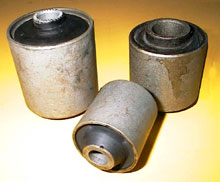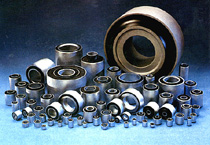 |

|
Rubber
Bushes |
|
Rubber bushes, consisting of cylindrical rubber tubes bonded/unbonded
on their outer and inner curves surfaces to rigid metal cylinders.
They are widely used as engineering components and designed to take
up torsional movement, radial and axial load and conical deflection.
The rubber is prestressed to give maximum dynamic strength and durability.
The bonded rubber takes up the full movement. Lubrication
and other bearing maintenance are required. The sleeves also have
excellent sound and vibration isolation capacity. Therefore, by
using rubber bushes will improve friction, wear and noise as well
as eliminate play completely and isolate high frequency vibrations.
Fixing the outer cylinder while the inner one undergoes
the following displacement may produce four principle modes of deflection:
1. Radial deflection
2. Axial deflection
3. Torsional deflection
4. Conical deflection
Example type of rubber bushes:
Simple bush, flanged bushes, laminated bushes, void bushes,
pivot bushes, spherical bushes, suspension bush, equalizer bush,
torque arm bushes, conical bushes, etc. Each of them is active under
different excitations and important for different NVH attributes.
For automotive application, the functions of rubber bushes are:
- Isolation of vibration
- Reduced transmission of noise
- Flexible load bearing members for joint of suspension system to frame and body
- Meeting low NVH
- Maintenance free
Manufacturing Process
- Preparation of rubber compound according to specification required
- Preparation of metal parts, cleaning and blasting, etc
- Application of adhesive
- Moulding of rubber compound with the metal part normally via compression or extrusion
- Painting
- Finishing
 |




